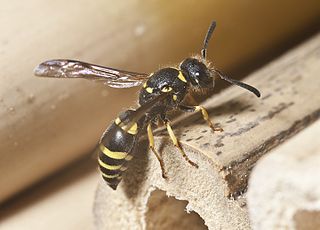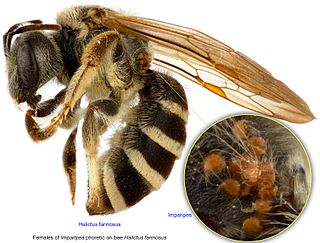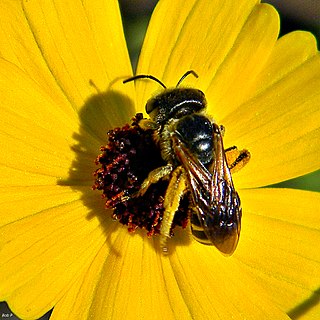
An acarinarium is a specialized anatomical structure which is evolved to facilitate the retention of mites on the body of an organism, typically a bee or a wasp. The term was introduced by Walter Karl Johann Roepke.

The Leucospidae are a specialized group of wasps within the superfamily Chalcidoidea, that are ectoparasitoids of aculeate wasps or bees. They are typically mimics of bees or stinging wasps, often black with yellow, red, or white markings, sometimes metallic, with a robust mesosoma and very strong sculpturing. The hind femora are often greatly enlarged, with a row of teeth or serrations along the lower margin as in Chalcididae. The wing has a longitudinal fold. The female ovipositor is sometimes short, but if not, it is recurved and lies along the dorsal side of the metasoma, a unique feature. The males are also unusual, in the fusion of many of the metasomal segments to form a capsule-like "carapace".

Ancistrocerus is a widely distributed genus of potter wasps present in many biogeographical regions of the world. They are nonpetiolate eumenine wasps with a transverse ridge at the bending summit of the first metasomal tergum and with a low and opaque propodeal lamella completely fused to the submarginal carina.

Bombus affinis, commonly known as the rusty patched bumble bee, is a species of bumblebee endemic to North America. Its historical range in North America has been throughout the east and upper Midwest of the United States, north to Ontario, Canada, where it is considered a "species at risk", east to Quebec, south to Georgia, and west to the Dakotas. Its numbers have declined in 87% of its historical habitat range. On January 10, 2017, the United States Fish and Wildlife Service placed B. affinis on the list of endangered species, making the rusty patched bumblebee the first bee to be added to the list in the continental United States.

Ancistrocerus nigricornis is a species of potter wasp.

Leucospis is a genus of wasps belonging to the family Leucospidae. Most species are brightly coloured with yellow and black patterning and about 2 cm long. They have characteristically enlarged femurs on the hind leg, with the lower margin toothed. The wings have a longitudinal fold and the long ovipositor is bent over their backs above the abdomen or metasoma. They are parasitic on wasps and solitary bees that construct cells and provision food for their offspring. The Leucospis larvae live and grow as ectoparasites of the host larvae. Usually, only one parasite emerges from a single cell. The genus Micrapion from South Africa is very closely related, and phylogenetic studies suggest merging of the two genera. The genus Leucospis is found across the world in the tropical regions.

Halictus farinosus is a species of ground-nesting sweat bee in the family Halictidae. The species is a primitively eusocial bee, of intermediate social strength when compared to other social species in the genus Halictus.

Hylaeus affinis is a species of hymenopteran in the family Colletidae. It is found in North America.
Calliopsis anomoptera is a species of bee in the family Andrenidae. It is found in Central America and North America.
Macrotera texana, the Texas macrotera, is a species of bee in the family Andrenidae. It is found in Central America and North America.

Florilegus is a genus of long-horned bees in the family Apidae. There are about 14 described species in Florilegus.

Bombus sonorus, commonly known as the Sonoran bumble bee, is a species of bumble bee in the family Apidae. It is found in Central America and western and southwestern North America. Considered uncommon, it is sometimes categorized as a subspecies of Bombus pensylvanicus.
Neolarra californica is a species of cuckoo bee in the family Apidae. It is found in the United States and Mexico. The species can be found in nests of Perdita difficilis bees.

The two-spotted miner bee is a species of miner bee in the family Andrenidae. It is found in Central America and North America. Members of the species have communal nests made of many cells. They live in desert scrub habitat. Their primary host plants belong to the genus Helianthus.

Macrotera latior is a species of bee in the family Andrenidae. It is found in Central America and North America.

Halictus poeyi, or Poey's furrow bee, is a species of sweat bee in the family Halictidae. It is found in the southeastern United States, and is morphologically indistinguishable from Halictus ligatus.
Lasioglossum subviridatum is a species of sweat bee in the family Halictidae. It is one of the few sweat bees that nests in wood, and thus prefers woodland habitats.

Ancistrocerus antilope is a species of wasp of the family Vespidae.














